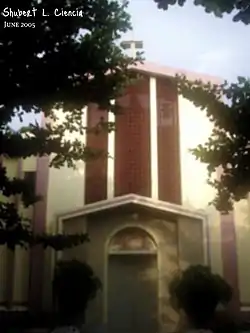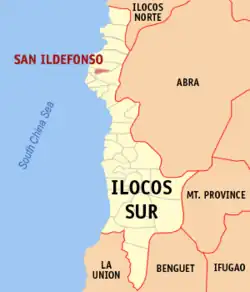San Ildefonso | |
|---|---|
| Municipality of San Ildefonso | |
 Parish Church of San Ildefonso | |
| Motto: Progreso San Ildefonso! (Progress San Ildefonso) | |
 Map of Ilocos Sur with San Ildefonso highlighted | |
OpenStreetMap | |
.svg.png.webp) San Ildefonso Location within the Philippines | |
| Coordinates: 17°37′38″N 120°23′38″E / 17.6272°N 120.3939°E | |
| Country | Philippines |
| Region | Ilocos Region |
| Province | Ilocos Sur |
| District | 1st district |
| Founded | March 1625 |
| Named for | Saint Ildefonsus |
| Barangays | 15 (see Barangays) |
| Government | |
| • Type | Sangguniang Bayan |
| • Mayor | Christian Daniel A. Purisima |
| • Vice Mayor | Robert R. Riego |
| • Representative | Deogracias Victor B. Savellano |
| • Municipal Council | Members |
| • Electorate | 5,836 voters (2022) |
| Area | |
| • Total | 11.35 km2 (4.38 sq mi) |
| Elevation | 10 m (30 ft) |
| Highest elevation | 47 m (154 ft) |
| Lowest elevation | 0 m (0 ft) |
| Population (2020 census)[3] | |
| • Total | 8,190 |
| • Density | 720/km2 (1,900/sq mi) |
| • Households | 1,976 |
| Economy | |
| • Income class | 5th municipal income class |
| • Poverty incidence | 3.84 |
| • Revenue | ₱ 93.78 million (2020) |
| • Assets | ₱ 458.5 million (2020) |
| • Expenditure | ₱ 69.23 million (2020) |
| • Liabilities | ₱ 37.86 million (2020) |
| Service provider | |
| • Electricity | Ilocos Sur Electric Cooperative (ISECO) |
| Time zone | UTC+8 (PST) |
| ZIP code | 2728 |
| PSGC | |
| IDD : area code | +63 (0)77 |
| Native languages | Ilocano Tagalog |
San Ildefonso, officially the Municipality of San Ildefonso (Ilocano: Ili ti San Ildefonso; Filipino: Bayan ng San Ildefonso), is a 5th class municipality in the province of Ilocos Sur, Philippines. According to the 2020 census, it has a population of 8,190 people.[3]
Etymology
The town got its name from Saint Ildephonsus.
History
San Ildefonso, like many other places in the provinces at the beginning of the Spanish Regime, did not have a name. Sometime in 1625, its inhabitants decided to give it a name, but nothing came out after more than five hours of discussions. So while thinking of a name, they decided to go fishing for a week. And while preparing to go fishing, they saw a box floating not far from shore. Wading to reach the box and carrying it ashore, they opened the box to find a statue of Saint Ildephonsus. The young women of the place carried the statue to the center of the village, where it was enshrined in a small hut for many years. He became the patron saint of the municipality, and his name was decided to become the name of the fledgling municipality.
San Ildefonso was a former rancheria of Bantay before it became a municipality, but because of its size it was annexed to Santo Domingo as a barrio. In 1921, Assemblyman (and future Philippine president) Elpidio Quirino worked to convert San Ildefonso into a municipality again.
200th Anniversary of Basi Revolt
On September 28, 2007, San Ildefonso officials (Governor Deogracias Victor Savellano and Rep. Ronald Singson) commemorated the Basi Revolt. Recently, the Sangguniang Bayan of San Ildefonso approved a resolution declaring September 16 as a non-working holiday and named the old road in Barangay Gongogong as Ambaristo street in honor of Pedro Ambaristo, leader of the Basi Revolt. Mayor Christian Purisima enrolled basi as their entry into the “One Town; One Product” (OTOP) program of Governor Savellano.[5]
Geography
San Ildefonso is 411 kilometres (255 mi) from Metro Manila and 6 kilometres (3.7 mi) from Vigan City, the provincial capital.
Barangays
San Ildefonso is politically subdivided into 15 barangays. Each barangay consists of puroks and some have sitios.
- Arnap
- Bahet
- Belen
- Bungro
- Busiing Sur
- Busiing Norte
- Dongalo
- Gongogong
- Iboy
- Kinamantirisan
- Otol-Patac
- Poblacion East
- Poblacion West
- Sagneb
- Sagsagat
Climate
| Climate data for San Ildefonso, Ilocos Sur | |||||||||||||
|---|---|---|---|---|---|---|---|---|---|---|---|---|---|
| Month | Jan | Feb | Mar | Apr | May | Jun | Jul | Aug | Sep | Oct | Nov | Dec | Year |
| Mean daily maximum °C (°F) | 30 (86) |
31 (88) |
33 (91) |
34 (93) |
33 (91) |
31 (88) |
30 (86) |
30 (86) |
30 (86) |
31 (88) |
30 (86) |
29 (84) |
31 (88) |
| Mean daily minimum °C (°F) | 19 (66) |
19 (66) |
21 (70) |
23 (73) |
25 (77) |
25 (77) |
24 (75) |
24 (75) |
24 (75) |
22 (72) |
21 (70) |
19 (66) |
22 (72) |
| Average precipitation mm (inches) | 9 (0.4) |
11 (0.4) |
13 (0.5) |
23 (0.9) |
92 (3.6) |
122 (4.8) |
153 (6.0) |
137 (5.4) |
139 (5.5) |
141 (5.6) |
42 (1.7) |
14 (0.6) |
896 (35.4) |
| Average rainy days | 4.6 | 4.0 | 6.2 | 9.1 | 19.5 | 23.2 | 24.0 | 22.5 | 21.5 | 15.2 | 10.5 | 6.0 | 166.3 |
| Source: Meteoblue (modeled/calculated data, not measured locally)[6] | |||||||||||||
Demographics
| Year | Pop. | ±% p.a. |
|---|---|---|
| 1903 | 2,137 | — |
| 1939 | 2,227 | +0.11% |
| 1948 | 2,034 | −1.00% |
| 1960 | 2,601 | +2.07% |
| 1970 | 3,400 | +2.71% |
| 1975 | 3,249 | −0.91% |
| 1980 | 3,640 | +2.30% |
| 1990 | 4,528 | +2.21% |
| 1995 | 5,232 | +2.74% |
| 2000 | 5,584 | +1.41% |
| 2007 | 6,670 | +2.48% |
| 2010 | 7,075 | +2.17% |
| 2015 | 7,787 | +1.84% |
| 2020 | 8,190 | +1.00% |
| Source: Philippine Statistics Authority[7][8][9][10] | ||
In the 2020 census, San Ildefonso had a population of 8,190.[3] The population density was 720 inhabitants per square kilometre (1,900/sq mi).
Economy
The town is rich in rice, corn, sugarcane, malunggay, katuday & fruit-bearing trees such as star apple, chico, mango, camachile & atis. Its main product is basi, a wine made from fermented sugarcane juice; as well as cane vinegar. They also make nutritious ice cream made up of vegetables in Barangay Bungro, and is being popularized by the town's local government.
Government
Local government
San Ildefonso, belonging to the first congressional district of the province of Ilocos Sur, is governed by a mayor designated as its local chief executive and by a municipal council as its legislative body in accordance with the Local Government Code. The mayor, vice mayor, and the councilors are elected directly by the people through an election which is being held every three years.
Elected officials
| Position | Name |
|---|---|
| Congressman | Deogracias Victor B. Savellano |
| Mayor | Christian Daniel A. Purisima |
| Vice-Mayor | Robert R. Riego |
| Councilors | Nona T. Purisima |
| Mariano M. Pamo Jr. | |
| Luzminda D. Padua | |
| Nelson T. Retreta | |
| Efren J. Pola | |
| Renato P. Pecho | |
| Richard A. Palomares | |
| Cesar R. Revibes | |
Education
- Belen National High School
- San Ildefonso Central School
- Bungro Elementary School
- Sagsagat Elementary School
- Busiing Elementary School
- Philippine Science High School - Ilocos Region Campus
- Day Care Centers (different barangays)
References
- ↑ Municipality of San Ildefonso | (DILG)
- ↑ "2015 Census of Population, Report No. 3 – Population, Land Area, and Population Density" (PDF). Philippine Statistics Authority. Quezon City, Philippines. August 2016. ISSN 0117-1453. Archived (PDF) from the original on May 25, 2021. Retrieved July 16, 2021.
- 1 2 3 Census of Population (2020). "Region I (Ilocos Region)". Total Population by Province, City, Municipality and Barangay. Philippine Statistics Authority. Retrieved 8 July 2021.
- ↑ "PSA Releases the 2018 Municipal and City Level Poverty Estimates". Philippine Statistics Authority. 15 December 2021. Retrieved 22 January 2022.
- ↑ Abs-Cbn Interactive, Ilocanos mark 200 yrs. of Basi Revolt
- ↑ "San Ildefonso: Average Temperatures and Rainfall". Meteoblue. Retrieved 14 May 2020.
- ↑ Census of Population (2015). "Region I (Ilocos Region)". Total Population by Province, City, Municipality and Barangay. Philippine Statistics Authority. Retrieved 20 June 2016.
- ↑ Census of Population and Housing (2010). "Region I (Ilocos Region)" (PDF). Total Population by Province, City, Municipality and Barangay. National Statistics Office. Retrieved 29 June 2016.
- ↑ Censuses of Population (1903–2007). "Region I (Ilocos Region)". Table 1. Population Enumerated in Various Censuses by Province/Highly Urbanized City: 1903 to 2007. National Statistics Office.
{{cite encyclopedia}}: CS1 maint: numeric names: authors list (link) - ↑ "Province of Ilocos Sur". Municipality Population Data. Local Water Utilities Administration Research Division. Retrieved 17 December 2016.
- ↑ "Poverty incidence (PI):". Philippine Statistics Authority. Retrieved December 28, 2020.
- ↑ "Estimation of Local Poverty in the Philippines" (PDF). Philippine Statistics Authority. 29 November 2005.
- ↑ "2003 City and Municipal Level Poverty Estimates" (PDF). Philippine Statistics Authority. 23 March 2009.
- ↑ "City and Municipal Level Poverty Estimates; 2006 and 2009" (PDF). Philippine Statistics Authority. 3 August 2012.
- ↑ "2012 Municipal and City Level Poverty Estimates" (PDF). Philippine Statistics Authority. 31 May 2016.
- ↑ "Municipal and City Level Small Area Poverty Estimates; 2009, 2012 and 2015". Philippine Statistics Authority. 10 July 2019.
- ↑ "PSA Releases the 2018 Municipal and City Level Poverty Estimates". Philippine Statistics Authority. 15 December 2021. Retrieved 22 January 2022.
- ↑ "2019 National and Local Elections" (PDF). Commission on Elections. Retrieved March 11, 2022.